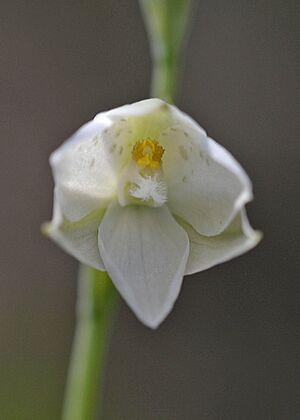Large-spotted sun orchid facts for kids
Quick facts for kids Large-spotted sun orchid |
|
|---|---|
 |
|
| Thelymitra juncifolia near Gherang | |
| Scientific classification | |
| Genus: |
Thelymitra
|
| Species: |
juncifolia
|
The Large-spotted sun orchid (Thelymitra juncifolia) is a special type of orchid flower. It grows naturally only in south-eastern Australia and in New Zealand. This orchid has a single, thin, dark green leaf. Its flowers are usually blue and have cool, dark blue spots on their top parts. It looks a bit like another orchid called T. ixioides, but the large-spotted sun orchid has fewer, smaller flowers with bigger spots.
Contents
What the Large-Spotted Sun Orchid Looks Like
The large-spotted sun orchid is a tuberous plant. This means it has a special underground stem, like a potato, that stores food. It is also a perennial herb, which means it lives for more than two years and does not have a woody stem.
Leaves and Flowers
This orchid has one long, dark green leaf. It can be like a thin thread or shaped like a spear. The leaf grows to be about 15 to 20 centimetres (6 to 8 inches) long and 0.8 to 1 centimetre (0.3 to 0.4 inches) wide.
The plant can have up to five flowers. These flowers are usually a greyish-blue to light blue color. They have bigger, darker blue spots on their top sepal (a leaf-like part that protects the flower bud) and petals. Each flower is about 2.5 to 3.5 centimetres (1 to 1.4 inches) wide. They grow on a flowering stem that is about 20 to 30 centimetres (8 to 12 inches) tall. The sepals and petals are around 1 to 1.3 centimetres (0.4 to 0.5 inches) long.
Inside the Flower
The central part of the flower, called the column, is white or blue. It is about 0.4 to 0.6 centimetres (0.16 to 0.24 inches) long. The top part of the anther (where pollen is made) is short and yellow or orange. It has a red or dark purple band on its back. This part also has many small, finger-like glands. The side parts of the column have soft, mop-like tufts of white or bluish hairs.
How it Reproduces
These orchids usually self-pollinate. This means they can make seeds using their own pollen. Sometimes, insects also help to pollinate them. The large-spotted sun orchid flowers from October to December.
Naming the Large-Spotted Sun Orchid
The scientific name for this orchid is Thelymitra juncifolia. It was first officially described in 1840 by a person named John Lindley. He wrote about it in his book called The Genera and Species of Orchidaceous Plants.
What its Name Means
The second part of its scientific name, juncifolia, comes from two Latin words.
- Juncus means "rush" or "bogrush," which is a type of plant.
- Folia means "leaves."
So, juncifolia means "rush-leaved," likely because its leaf looks a bit like the leaves of a rush plant.
Where the Large-Spotted Sun Orchid Lives
The large-spotted sun orchid is very common in many parts of Australia. You can find it growing in different places like:
- Heath (areas with low-growing shrubs)
- Forests
- Woodlands
- Scrub (areas with small trees and bushes)
It grows in several Australian states and territories, including New South Wales, the Australian Capital Territory, Victoria, South Australia, and Tasmania.


